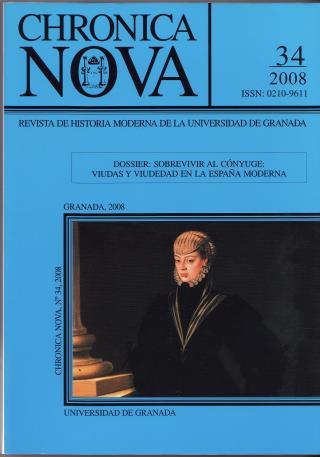The widow queen or the death of the symbolic body
DOI:
https://doi.org/10.30827/cn.v0i34.1647Keywords:
Widow queen, Queen mother, Governor, Regent, Symbolic body, Sterility, PanegyricsAbstract
In the early modern age the queen’s figure was constructed on an ideal base of women as, wife and mother of the king. Accordingly, to be a widow queen would be faced as a drama: these women would die like queens but would still live as women; this situation would be marked in case of queens with no lineage to perpetuate the dynasty. This article faces the analysis of this problem across discourse of panegyrists and the moralists, on the crossroads of 1700, age where various queens coexisted. Two of these queens were widows without children (Marianne of Neoburg and Louise Elisabeth d’Orléans) and two other queen widows with descendants (Marianne of Austria and Elisabeth Farnese). These accounts tell how men built an ideal and an image, with the intention of spreading a representation model for the rest of the elite women, the rest of the common people and for the queens to come.
Downloads
Downloads
Published
How to Cite
Issue
Section
License
Nuestra revista se atiene a las recomendaciones para la implementación del Artículo 37 Difusión en Acceso Abierto de la Ley de la Ciencia, la Tecnología y la Innovación:
- Los/as autores/as cuyas contribuciones sean aceptadas para su publicación en esta revista conservarán el derecho no exclusivo de utilizar sus contribuciones con fines académicos, de investigación y educativos, incluyendo el auto-archivo o depósito de los artículos aceptados en repositorios institucionales o temáticos de acceso abierto de cualquier tipo en un plazo máximo de seis meses.
- Preferiblemente se permitirá el uso de la versión publicada de las contribuciones científicas, que estarán accesibles en abierto tan pronto como sea posible.
-
Que en caso de que el trabajo sea aprobado para su publicación, el/la autor/a autoriza de manera ilimitada en el tiempo a la entidad editora para que incluya dicho texto en Chronica Nova y pueda reproducirlo, editarlo, distribuirlo, exhibirlo y comunicarlo en el país y en el extranjero por medios impresos, electrónicos, CD, Internet o cualquier otro medio conocido o por conocer.






 ISSN-e: 2445-1908
ISSN-e: 2445-1908










